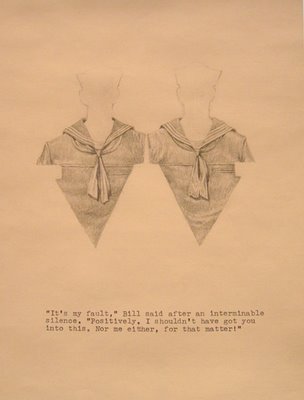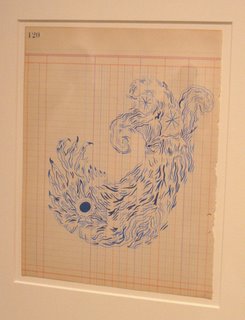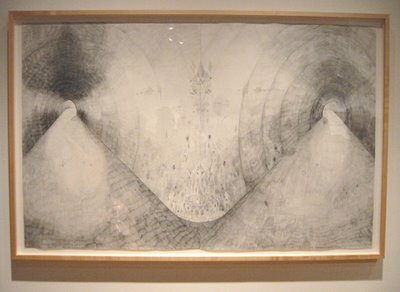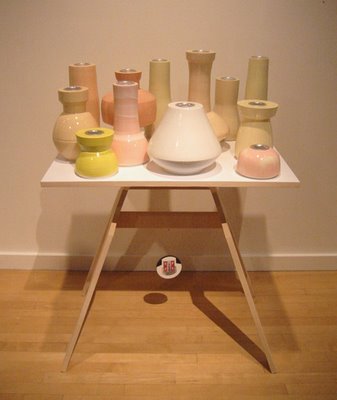 The title of the new group show at Rena Bransten Gallery is “On the Road Again: Beat Culture, Bush Era.” I have no idea what this means. If you saw the show without knowing the title and then were asked to pick a suitable title from dozens of possibilities, I doubt you'd pick this one. A more relevant banner would have been “Boy Band,” for there is nary a woman in this show.
The title of the new group show at Rena Bransten Gallery is “On the Road Again: Beat Culture, Bush Era.” I have no idea what this means. If you saw the show without knowing the title and then were asked to pick a suitable title from dozens of possibilities, I doubt you'd pick this one. A more relevant banner would have been “Boy Band,” for there is nary a woman in this show.It’s a good show, though. There is a lot of drawing but also sculpture, collage, and film. Nearly all the artists are based in San Francisco.
Colter Jacobsen contributes a group of small graphite drawings in which he extracts imagery from a friend’s postcard collection and presents it with words from another friend (typewritten). Here are two examples, which also reflect the artist’s long-standing interest in pairings:

 The well-known singer Devendra Banhart has two small drawings in the show. Here is one:
The well-known singer Devendra Banhart has two small drawings in the show. Here is one: Oliver Halsman Rosenberg contributes several medium-sized drawings. In one of them, perhaps my favorite, a cube in muted primary colors takes on a mandala effect as it dematerializes and changes perspective:
Oliver Halsman Rosenberg contributes several medium-sized drawings. In one of them, perhaps my favorite, a cube in muted primary colors takes on a mandala effect as it dematerializes and changes perspective: On a larger scale, Jay Nelson offers three imaginary landscapes in graphite. The largest of these (about 41 x 63 inches) depicts two tunnels coming together. There are delicate details that might be markings on the tunnel walls or hieroglyphic leakage from another plane of reality. The work is splendid but hard to photograph. Here is my attempt:
On a larger scale, Jay Nelson offers three imaginary landscapes in graphite. The largest of these (about 41 x 63 inches) depicts two tunnels coming together. There are delicate details that might be markings on the tunnel walls or hieroglyphic leakage from another plane of reality. The work is splendid but hard to photograph. Here is my attempt: The remaining flat works—by Erik Frydenborg and Geof Oppenheimer—employ drawing and collage. The sole film work is by Oppenheimer. Opening night chatter overwhelmed the audio of this piece. The film was projected on a portable screen by a looping projector whose elaborate threading mechanism may have been more compelling than the film. Here’s a shot of the screen:
The remaining flat works—by Erik Frydenborg and Geof Oppenheimer—employ drawing and collage. The sole film work is by Oppenheimer. Opening night chatter overwhelmed the audio of this piece. The film was projected on a portable screen by a looping projector whose elaborate threading mechanism may have been more compelling than the film. Here’s a shot of the screen: Rounding out the show are three floor-standing sculptures by Ian McDonald. Two of these employ his signature ceramic vessels known as “breathers,” which have tiny metal vents in their tops. In one case, the breathers resemble a cluster of aliens waiting in a decompression chamber, or maybe a decontamination chamber (photo at top). An intriguing work, and an early sale.
Rounding out the show are three floor-standing sculptures by Ian McDonald. Two of these employ his signature ceramic vessels known as “breathers,” which have tiny metal vents in their tops. In one case, the breathers resemble a cluster of aliens waiting in a decompression chamber, or maybe a decontamination chamber (photo at top). An intriguing work, and an early sale.In the other case, the breathers are presented as chic objects on a crisp table, under which dangles another signature device, a ceramic decal based on military insignia.
 A good deal of McDonald’s work addresses symbols of personal identity, including identities claimed through the deployment of Modernist objects. The decal for the above piece is forthright about the social cachet these symbols are designed to create (see close-up below).
A good deal of McDonald’s work addresses symbols of personal identity, including identities claimed through the deployment of Modernist objects. The decal for the above piece is forthright about the social cachet these symbols are designed to create (see close-up below).

No comments:
Post a Comment